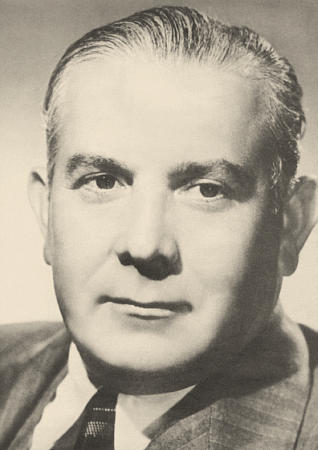BACK TO THE LIBRARY BACK TO THE LOBBY


CinemaScope is no longer news. It is accomplished fact. Its revolutionary aspects and acceptance by industry and public have been confirmed. Its universal acceptance, further, is attested by the fact that CinemaScope will be included in dictionaries of the future. The word, and all that it exemplifies, cinematically, is understood in every language. No translation into any foreign tongue is necessary, for CinemaScope speaks for itself.
But, materialization of CinemaScope itself is a short story-for less than 10 months lapsed between the time when Spyros P. Skouras (right), President of 20th Century-Fox, first viewed a demonstration of the anamorphic lens in France to the world premiere of the first CinemaScope production, "The Robe," at the 6000-seat Roxy theatre in New York City on Sept. 16. But, it is a chapter already written in indelible ink on the history pages of this industry, thanks to the vision and foresight of Mr. Skouras; Darryl F. Zanuck, Vice-President in charge of production; Al Lichtman, director of distribution and W.C. Michel, executive Vice-President, and the technical genius of Earl I. Sponable, 20th Century-Fox's director of technical research; Mr. Sponable's chief assistant, Herbert Bragg, and Sol Halprin, studio Camera Department head, and their staffs.
When Mr. Skouras attended the first demonstration of the anamorphic lens invented by Prof. Henri Chretien (left), he envisioned a new horizon in motion picture technique. Technically, it has been characterized as the greatest development since the introduction of sound, some 25 years ago.
CinemaScope consists of (a) an anamorphic lens, (b) the Miracle Mirror Screen, (c) stereophonic sound and (d) a new four-track single film projection.
The anamorphic lens restores to its original shape an image previously distorted in filming. This lens makes it possible for a 35mm camera to "reach out" to each side, as the eye does, and "compresses" a wide angle scene into a narrow strip of film. When this film is projected through a compensating lens it spreads the image horizontally.
The Miracle Mirror Screen with millions of tiny "lenses" reflecting greater light is an all-purpose screen, completely compatible with and suitable for CinemaScope, standard, 3-D and other wide-screen projection systems, giving added brilliance to the projected image. However, CinemaScope productions are available to any exhibitor who can provide a satisfactory projection on whatever screen used.
Stereophonic sound, a high fidelity sound system, uses a multiplicity of sound tracks which, when wired to speakers strategically placed in the theatre, correspond to sound emanating from the actual person or persons, or locations on the screen, affording an extraordinarily natural and realistic effect. Furthermore it adds dramatic dimensions to the screen, giving the feeling of participation with the action being viewed.
CinemaScope is not a substitute for a story, or merely for good actors. But, it does give the studio more octaves in which to tell the story and, also, it provides actors greater range for their talents. It provides the intimacy of a stage play, the movement and variety of films, plus an unprecedented potential for the effective presentation of both. The CinemaScope filming technique gives the actor the satisfaction of "living" his part, not fragmentarily, but completely, this yielding a greater performance.